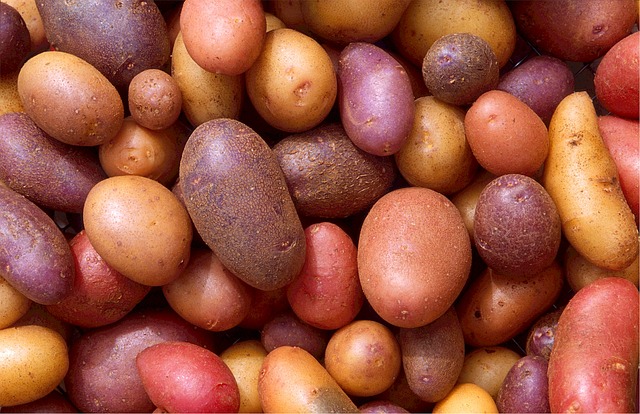Did you know that there are an estimated 200 varieties of potatoes sold in the United States? Yes, potatoes come in more kinds other than usual Idaho and sweet potato. They are broken down into three classifications based on the cooked texture and ingredient usage. Our guide breaks down the differences between the most popular potatoes and how they should be prepared.
Starchy
The most common type of potato falls under the starchy category, these include Russets and some types of yams and sweet potatoes. Starchy potatoes are, you guessed it, high in starch. They are also low in moisture and absorbent which makes them perfect for baking, mashing, boiling, and frying. Since their flesh separates after cooking, they don’t hold their shape well. Here some common starchy potato varieties:
Russet

Russet, also known as Idaho potatoes are usually long and large in size and have a rough skin. They are best for frying, baking, and they are especially ideal for mashing. Their skin falls right off after being boiled and its texture stays light and fluffy once it’s whipped. If you have a sack of potatoes lying in your kitchen cabinet but don’t want to make the usual mashed potatoes, shred them up and make delicious breakfast hashbrowns or scallop them and serve with a juicy steak or succulent meatloaf.
Sweet Potatoes

The sweet cousins to Idaho potatoes are sweet potatoes and yams. Sweet potatoes can be identified by their oblong shape and tapered tip. Their skin can be white, yellow, red, purple or brown, and their flesh can be yellow, white, orange, or a reddish-orange. The most common sweet potato sold in grocery stores have reddish-brown skin and orange flesh. All varieties of sweet potatoes are great for roasting, baking, steaming, boiling, mashing, pureeing, and using them in desserts–sweet potato pie, anyone?
Yams

Contrary to belief a yam is not a sweet potato and vice versa. In fact, they are two different plants. To explain, sweet potatoes are in the morning glory family and yams are related to palms and grasses. In addition, yams are grown in Africa, where they originated, and also the Caribbean, Southeast Asia, and Central America. Sweet potatoes, on the other hand, are grown in the United States, with most coming from North Carolina. Therefore, the chances of you purchasing a real yam at your local grocery store is pretty slim. Yams are usually imported and are very hard to find.
To tell a yam and sweet potato apart just look that its shape. As mentioned earlier, sweet potatoes are long with tapered ends, and a yam is cylindrical. As far as their taste, they are dry, starchy and vastly different from sweet potatoes.
Waxy
No, waxy potatoes are not made of wax, but they low in starch, high in sugar, and moisture. They have a thinner skin than starchy potatoes and are usually smaller and rounder. Some varieties include French fingerling and Red Bliss. They hold their shape well after cooking and are perfect for boiling, roasting, and incorporating in dishes like potato salad.
Red Potato

Red potatoes are round, small, and thin-skinned. Their flesh is white and waxy and is creamy when cooked. Some varieties of red potatoes are Red Bliss, Norland, and Red Pontiac. Red potatoes are great when roasted, steamed, or boiled. You can even simmer them and toss them in soup or stew. Try out this perfect potato soup recipe for a yummy and comforting lunch idea.
All-Purpose
All-purpose potatoes like Yukon Golds are lower in starch than the typical high starch potato. They are holding their shape well, are absorbent and fluffier which makes them ideal for any type of potato dish.
White Potato

White potatoes have a thin gold colored skin and yellow or white flesh. The most common variety of all-purpose potatoes, Yukon Gold, is known for its medium size and thin pale yellow skin. Their creamy texture and buttery flavor set them apart from any other type of white potato. They can be boiled, mashed, baked, roasted or fried. You can even slice them up and make mouth-watering seasoned potato wedges.
Purple Potatoes

Purple potatoes are probably the most beautiful and exotic potatoes on this list. These vibrant taters are known for their firm and starchy flesh and earthy and nutty flavor. When cooked, the skin darkens and the skin lightens a bit. Like the previously mentioned all-purpose potato, purple potatoes can be included in any dish. Unlike most spuds on included on this list, purple potatoes are loaded with antioxidants, thanks to the anthocyanins in their flesh. Some varieties of purple potatoes include Purple Majesty (fancy!), Purple Peruvian, All Blue, and Purple Viking.
Tips for Selecting, Storing, and Cleaning Potatoes
When selecting potatoes, choose ones that are firm and heavy with clean skin and few indents. They should be free of cracks, soft spots, and cuts. Also, avoid any potato with spuds or a green hue. This means that they’ve been overexposed to light and released too much solanine, a chemical that could be harmful when ingested.
Properly store your potatoes in a cool and dark area. Warm of humidity will cause them to sprout or go bad. Also, be sure not to refrigerate potatoes, for this converts starch into sugar which will result in a sweet taste and potentially cause burning when fried. When stored properly starchy and waxy potatoes should last for up to two months, and waxy potatoes a couple of weeks.
The best way to clean potatoes is with warm water and a scrub brush. Lightly scrub away any dirt and rinse before peeling. Another way to clean your potatoes is by soaking them in a pot full of warm water–the dirt falls right off.
